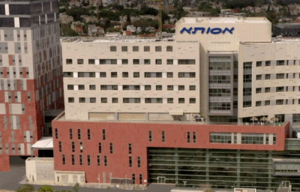CyberKnife
CyberKnife is a high-tech treatment method for cancer and other tumors that uses precise beams of radiation to destroy cancer cells. The key feature of this method is its exceptional precision. CyberKnife can target tumors with minimal impact on surrounding healthy tissues, making it an excellent option for treating hard-to-reach or radiation-sensitive areas.
According to clinical studies, CyberKnife demonstrates high efficacy in treating various types of cancer. For instance, in early-stage lung cancer, this method can provide a 5-year survival rate of up to 90%. In the treatment of brain metastases, CyberKnife achieves disease control in 80-90% of patients.
Advantages of CyberKnife
- Minimally invasive: The procedure does not require incisions or anesthesia.
- Precision: Radiation beams are delivered with sub-millimeter accuracy, reducing the risk of damage to surrounding healthy tissues.
- Patient comfort: The procedure is painless and does not require prolonged recovery.
- Few treatment sessions: Therapy may consist of a few short sessions, reducing the overall treatment time.
Indications for CyberKnife treatment
CyberKnife is used to treat a wide range of tumors, including:
- Brain cancer (including metastases)
- Lung cancer
- Liver cancer
- Pancreatic cancer
- Spinal tumors
- Certain types of benign tumors (e.g., meningiomas)
This method is often used for tumors that cannot be surgically removed or in cases where traditional surgery is contraindicated.
How virotherapy is performed in leading international clinics
The CyberKnife treatment process includes several stages:
- Preparation: Prior to treatment, comprehensive planning is conducted. Detailed imaging of the tumor is obtained (e.g., via CT or MRI) to determine the exact location and shape of the tumor.
- Patient positioning: During the procedure, the patient lies on a special table that can move to help precisely direct the radiation beams. The CyberKnife system continuously monitors even the slightest patient movements (such as breathing) and adjusts the beam’s direction accordingly.
- Radiation session: Radiation beams are delivered to the tumor from multiple different angles. The procedure typically lasts between 30 and 90 minutes. Treatment may involve one or several sessions, depending on the size and location of the tumor.
Features of the procedure in international clinics
- No hospitalization required: Most patients can return to their regular activities immediately after the procedure.
- Painless: The treatment is pain-free and does not require anesthesia.
- Short-term side effects: Mild fatigue or skin irritation in the treatment area may occur, but serious complications are rare.
Top clinics
-
 University Hospital Freiburg
University Hospital Freiburg -
 Acibadem Altunizade Clinic
Acibadem Altunizade Clinic -
 Medistate International Hospital
Medistate International Hospital -
 Medical Park Antalya Clinic
Medical Park Antalya Clinic -
 Milan, Italy San Donato Hospital in Milan, Italy
Milan, Italy San Donato Hospital in Milan, Italy -
 Milan, Italy San Raffaele University Hospital
Milan, Italy San Raffaele University Hospital -
 American Hospital Dubai
American Hospital Dubai -
 Burjeel Hospital Abu Dhabi
Burjeel Hospital Abu Dhabi -
 Debling Private Clinic
Debling Private Clinic -
 Rudolfinerhaus Private Clinic.
Rudolfinerhaus Private Clinic. -
 University Hospital Heidelberg
University Hospital Heidelberg -
 Vienna, Austria Wiener Privatklinik (WPK)
Vienna, Austria Wiener Privatklinik (WPK) -
 Munich, Germany University Hospital Munich (Ludwig-Maximilians-Universität)
Munich, Germany University Hospital Munich (Ludwig-Maximilians-Universität) -
 Asklepios Nord Heidberg
Asklepios Nord Heidberg -
 Charité Clinic
Charité Clinic -
 Gil Medical Center at Gachon University
Gil Medical Center at Gachon University -
 Barcelona, Spain QuironSalud Barcelona Hospital
Barcelona, Spain QuironSalud Barcelona Hospital -
 Barcelona, Spain Medical Center "Teknon"
Barcelona, Spain Medical Center "Teknon" -
 Barcelona, Spain Sant Joan de Deu Children's Hospital
Barcelona, Spain Sant Joan de Deu Children's Hospital -
 Barcelona, Spain University Hospital Barnaclinic+
Barcelona, Spain University Hospital Barnaclinic+ -
 Madrid, Spain University Hospital HM Monteprincipe
Madrid, Spain University Hospital HM Monteprincipe -
 Gebze, Turkey Anadolu Clinic
Gebze, Turkey Anadolu Clinic -
 Zurich, Switzerland Hirslanden Clinic
Zurich, Switzerland Hirslanden Clinic -
 Madrid, Spain Quiron Salud University Hospital
Madrid, Spain Quiron Salud University Hospital -
 Seoul, South Korea Samsung Medical Center
Seoul, South Korea Samsung Medical Center -
 г. Женева, Швейцария Клиника «Женераль-Болье»
г. Женева, Швейцария Клиника «Женераль-Болье» -
 г. Стамбул, Турция Университетская клиника «Медиполь Мега»
г. Стамбул, Турция Университетская клиника «Медиполь Мега» -
 г. Сеул, Южная Корея Медицинский центр «Асан»
г. Сеул, Южная Корея Медицинский центр «Асан» -
 г. Рамат-Ган, Израиль Клиника Шиба
г. Рамат-Ган, Израиль Клиника Шиба -
 г. Тель Авив, Израиль Медицинский центр “Ассута”
г. Тель Авив, Израиль Медицинский центр “Ассута” -
 г. Петах-Тиква, Израиль Медицинский центр имени Ицхака Рабина
г. Петах-Тиква, Израиль Медицинский центр имени Ицхака Рабина -
 г. Иерусалим, Израиль Медицинский центр “Хадасса”
г. Иерусалим, Израиль Медицинский центр “Хадасса”






























